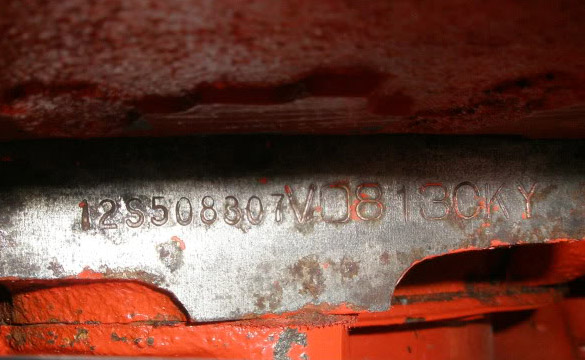For years Corvette experts, restorers, and judges have debated the topic of engine stamp pads. Who would have thought that such a small area of metal with some numbers stamped in it could cause so much debate? As the Corvette hobby and vehicle values have grown there’s been an increasing focus on OEM stamps from the plant versus restoration restamps and outright fraud. In response to all the discussions, Bloomington Gold has come up with a series of standards to address this controversial topic.
Bloomington Gold’s goal was to increase appreciation for true original motor cars as well as for great Corvettes with replacement engines. Additionally they hope to deter deceptive restamps in addition to better clarifying the differences between all 3.
After a significant amount of research into this topic Bloomington Gold has devised a new way to address stamp pads during their judging process.
In order to get a Gold Certificate your engine block can fit into 1 of 3 categories:
- Appears OEM: No detectable deviation from known OEM stamps. Things like ghosts, rust, damage, or anomaly are OK.
- Inconclusive: There is a detectable deviation (size, font, shape, location, etc.) which is unknown among OEM stamp variations, yet unclear to inspector team whether or not it’s an OEM stamp. Authenticity of the stamp cannot be conclusively determined.
- Owner Declared Non-OEM: If the owner openly declares this on their judging application, the engine stamp pad will NOT be evaluated by an inspector but the car still remains eligible for a Gold Certificate. Stamps may range from nearly perfect replicas to generic or totally missing. Since it has already been declared Non-OEM by the owner, there is nothing left for the inspectors to determine.
A rule of thumb Bloomington has developed is: If the OWNER declares the stamp to be Non-OEM, the vehicle can get a Gold that year. If the INSPECTORS (judges) declare the stamp to be Non-OEM, the vehicle can not get a Gold that year. If the latter occurs, note that you can bring your car back the following year and be Gold-eligible if you state Non-OEM on your registration form.
In addition to all of this, they’ve developed a standardized glossary of terms to apply to stamp pads. Everything from „Original Block“ to „CE Stamp is discussed. You can check out the glossary below in the attachments.
Ultimately what Bloomington Gold is stating is that as long as your car scores at least 95% and the engine stamps APPEAR OEM, INCONCLUSIVE, or are Declared NON-OEM by the owner, it can be Gold Certified.
The final big change was to the Gold Certificate itself. A section has been added to the form indicating which engine stamp designation was given to that car on the day which it was judged. Below the date, VIN, and owner’s name the certificate will indicate that the stamp appears OEM, is inconclusive, or owner declared OEM. You can check out the new Gold Certificates below.
All these changes, clarifications, and standards should help to put more emphasis on true OEM-block cars without overly penalizing excellent Corvettes with replacement blocks.
Bloomington Gold has published several documents summarizing this stamp pad project. We’ve attached them below. There’s a ton of information in there, but well worth the read.
- The Standards
- Certificate Samples
- Sample Judging Sheet
- Special Warning
- Owner Declarations
- Reasons for Change
What do you think of Bloomington’s new stamp pad standards? Good? Bad? We know there endless thoughts on this topic so let us know what you think in the comments section below.
Source:
Bloomington Gold
Related:
Bloomington Gold Corvette Show Moving to Champaign, IL in 2013
Bloomington Gold 2011: Certification Day
Mecum’s Bloomington Gold Auction Rakes in $5.8 million in Corvette Sales
-




![[PODCAST] CORVETTE TODAY #210 – Celebrating 50 Years of the NCRS [PODCAST] CORVETTE TODAY #210 - Celebrating 50 Years of the NCRS](https://www.corvetteblogger.com/images/content/uploads/2024/04/042224_1-218x150.jpg)